Movements and habitat use of cisco along a nearshore-offshore gradient in northern Lake Huron
Contributing Authors
Christopher Holbrook (USGS, cholbrook@usgs.gov), Todd Hayden (USGS), Kevin McDonnell (USFWS), Thomas Binder (USGS), Aaron Fisk (University of Windsor)
Project Description
Ciscoes (Coregonus artedi) were an abundant prey fish that linked lower and upper trophic levels in each of the Great Lakes until overexploitation, non-native fish invasions, and environmental degradation resulted in large-scale extirpation and range reduction in the early 1900s. Presence of closely-related but distinct morphotypes (forms) coexisting in each lake suggests that cisco populations are highly adapted to their local environment, yet basic knowledge of behavioral ecology (e.g., spawning behavior, habitat, site fidelity, home range) critical for restoration and management is poorly understood. Historically, two cisco morphotypes were described in Lake Huron but recent investigations of cisco morphometry have identified a previously undescribed form (so-called "shorthead” cisco) found in the nearshore waters of the main basin of Lake Huron near the Straits of Mackinac (Les Cheneaux Islands archipelago and Drummond Island), the St. Marys River, the North Channel, and Georgian Bay. Shorthead cisco are thought to be a coastal form of cisco that complete their life cycles in shallow, nearshore habitats with relatively small home ranges in contrast to the pelagic-oriented "typical artedi" cisco considered extirpated from Lake Huron, but similar to cisco found in Lake Superior. Re-establishing pelagic cisco in Lake Huron is a primary goal of managers but introduction of pelagic cisco from Lake Superior has been avoided to prevent loss of biodiversity of remnant cisco genotypes in Lake Huron. The shorthead cisco is now being used to support stocking into Saginaw Bay because these remnant populations possess traits that have allowed them to survive in Lake Huron, although little is known about habitat preferences and life history. Understanding habitat preferences and seasonal behavior of shorthead cisco is not only critical to the stocking program in Lake Huron but may also inform use of this form for restoration stocking in other Great Lakes. The purpose of this study is to test the hypothesis that habitat use, seasonal movements, and spawning habitat of shorthead cisco in northern Lake Huron is restricted to nearshore, shallow-water coastal environments. This project addresses several needs identified by the basin-wide adaptive management framework. Resolving fish movements between two habitats (coastal and offshore) in Lake Huron provides insight on possible hydrographic barriers to gene flow and will help to explain patterns observed in population genetics structure. This study will provide direct observation of the extent of movements between nearshore and offshore pelagic areas that is critical for determining when, where, and which morphotype should be stocked to achieve restoration goals and conserve biodiversity.
